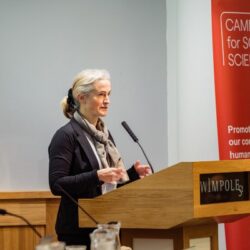Watch the Archived Webinar: Demystifying Academic Processes: From Publishing Your Research to Promoting it
With so many factors to consider in publishing your academic research – such as which research questions to ask, methodologies to use, how to get peer reviewed, what ethics standards to follow, and how to promote research – how can you “make your manuscript different, worthy, and merit publication?”
The hour-long webinar “Demystifying Academic Processes: From Publishing Your Research to Promoting it,” hosted by SAGE Publishing, Georgia State University, and GSU’s Diverse Faculty Alliance (DFA), answered three main questions: How can you get published in an academic journal (whether an early career researcher or veteran)? How can you promote your publications? And how should you think about measuring impact?
You can watch a full recording of the event here:
Featuring editorial experts Dawn A. Rowe (editor of TEACHING Exceptional Children), Norma Cuellar (Journal of Transcultural Nursing), and Ana Christina da Silva Iddings (Urban Education), as well as SAGE Publishing’s Karen Shrayer and Jessica Lipowski, the event highlighted practical advice on research methods, collaboration, peer review engagement, and promoting work. (Full biographies appear below.)
“When you are sending a manuscript to a journal,” da Silva Iddings observed, “it’s important to think of it as an offering, you are making an offering to the public, so how do you make that offering in a way that really reflects your identity as a scholar?”
The webinar was introduced by Laura Edmunds, chair of Georgia State’s Women’s Faculty Identity Group, and Curtis Byrd, special advisor to Georgia State’s Provost for Diversity, Equity, and Inclusion. The affinity groups which make up the DFA focus on promoting conversations, community engagement, and advocacy for diversity, equity, and inclusion, with an emphasis for underrepresented minority faculty.
Extra insights from the panelists
Additionally, we followed up with panelists on the few questions we were unable to answer during the Q&A. You can find those, as well as a list of the recommended resources mentioned during the event, below.
Is it fine to be the second or third author all the time in a peer-reviewed journal? Or is it important to be the first author at least once for academic growth?
While collaborations are encouraged by most colleges and universities I have worked with, for the purposes of tenure and promotion, being second and third author do not count as much as being the first author.
Being the first author in research articles usually means that you are using your own data and your own analysis. Therefore, the compilation of first-authored articles will give direction and focus to your work and career and provide you with an identity as a scholar.
– Christina Da Silva
In the beginning of your career, not being first author is fine as you are learning. However, as a scholar in your area, you need to be first author in the majority of your publications that are listed on your CV. Being a first author signifies that you have done the majority of the work on the publication specifically the scholarship (developing, implementing, and dissemination of project).
As part of your scholarly trajectory, you must show that you have the expertise and being first author is one way of doing this.
-Norma Cuellar
You will want to refer to the tenure and review policies at your institution, but in general scholars are encouraged to take on manuscripts as well as be the second or third author. This does support academic growth but also contributes to your impact on the field.
-Dawn Rowe
The speakers indicated that the editors/reviewers like that there are multiple authors, but if the submission is blinded how are they evaluating this?
Sometimes authors number the authorship in the citations or in the narrative. For example, “Author 1 is the Principal Investigator for this study, Author 2 is a classroom teacher who collaborated in this participatory research, etc. . .”
– Christina Da Silva
Blinding is for the reviewers. No names will be passed on when the manuscripts go to the reviewers. The reviewers do not know who wrote the manuscript. Yes, the editors know the authors – this is necessary to assign reviewers who are experts in the area of the topic. For my journal, I make a final decision based on the reviewers’ comments and recommendations..
-Norma Cuellar
Speaking for TEACHING Exceptional Children, this is not something we monitor. Editors are privy to this information; however reviewers are not because of the double blind review process. Multiple authors are encouraged for TEC to promote collaborative inquiry and collaborative practices which is essential in our field. Collaboration is a research-based practice that we promote.
-Dawn Rowe
I’m a master’s student. It will be my first publication. I can only have my classmates to have a look at my article. I wonder if you can provide a support in this regard?
Yes, some journals and professional organizations (e.g., NCTEAR) have mentoring sessions for those who would like to write for publication. You can reach out and inquire about it in your respective professional organizations.
– Christina Da Silva
You have more people in your life than you realize. Who do you work with that has a higher degree than you do? Your faculty (as already mentioned) can help you. Your mentors should help you (and yes, you should have mentors by now that do this for you). Don’t be afraid to ask – I think that is the main issue here.
-Norma Cuellar
We recommend you reach out to one of your professors or faculty in your department, perhaps even a mentor. They might be able to provide advice regarding your article. We at SAGE also offer professional end-to-end support to help make sure your next research paper meets format, language, and style requirements. Our SAGE Author Services include English language editing and manuscript formatting, among other services. The pricing depends on the service you select and manuscript length. Learn more here: https://languageservices.sagepub.com/en/ . I would agree with Jessica here. You can also reach out to other resources within the university. Many universities have writing centers or other programs that would provide these services to students.
-Dawn A Rowe
Please explain these open access charges.
Publishing an article Open Access means the article is published under a Creative Commons license and is available to everyone, free to read, regardless if that user subscribes to the journal. You can publish your research in a fully Gold Open Access journal, where the entire journal is free to read, or in a hybrid format, where you are publishing your research Open Access in a traditional subscription journal. Authors must pay an Article Processing Charge (APC). The standard SAGE Choice APC is US$3,000. The APC for Gold OA journals varies. You may also be eligible for a discounted APC through your institution.
Please visit this page for more details: https://us.sagepub.com/en-us/nam/faqs
-Jessica Lipowski
When you submit to a journal to publish, there are a lot of people involved in the process (that do this as a job and get paid). I have an administrative assistant who gets paid to receive the manuscripts and go through them to make sure they have followed all the necessary requirements for the journal. I have an administrative editor from SAGE. There is a production line for getting every article published. There are people who read the journal for grammar, etc. There is a process of sending back the manuscript to the author for legal paperwork, then there is the publishing of the journal itself. Then, when it is published, people have to publish the journal or the article to read it. The journal owns the article.
In open access, you are essentially paying for this – all out of your pocket. Everyone can ready your manuscript which makes it more visible. This also increases your H-factor because you could be cited more. The manuscript is often published much quicker than if it went through the journal for access. For health care, NIH funding now includes budget line item for open access publications because they want NIH research in the public, at no cost to people in the United States. Costs of open access can be anywhere from $500 to $10,000, so be careful. Do not confuse open access with predatory journals because NOW many reputable journals have the option of doing both for you. You can decide.
– Norma Cuellar
Here’s a wealth of tips for getting that first – or 50th – journal article published:
- SAGE Publishing’s Author Gateway
- Some blog posts about writing journal articles with links to hints on writing books and Academic Writing Month
- Specific guidance for health researchers
Ethical standards for authors:
Promoting your article (and yourself!):
Beware of those ‘predatory journals’:
Peer reviewing:
Panelist biographies
Karen Shrayer manages and acquires journals in education and special education for SAGE. As a publishing editor, she works closely with associations to manage the business and editorial development of their journals.
Dawn A. Rowe is an associate professor in the department of Educational Foundations and Special Education at East Tennessee State University. Rowe serves as the academic editor for the Council for Exceptional Children’s research-to-practice journal, TEACHING Exceptional Children. Her publications have focused on transition assessment, transition skill instruction for low incidence disabilities, and family engagement.
Jessica Lipowski is a publishing editor at SAGE. She manages a range of science and medicine journals, working with editors and societies to develop new strategies and problem solve.
Norma Cuellar teaches at the Capstone College of Nursing at the University of Alabama. Her expertise is in issues around cultural diversity. Her research focus has been health disparities and workforce diversity. She has served as editor of the Journal of Transcultural Nursing for seven years and served as the national president of the National Association of Hispanic Nurses
Ana Christina da Silva Iddings is a professor of the practice of learning, diversity, and urban studies at Vanderbilt University’s Peabody College. She is the editor of Re-Designing Teacher Preparation for Culturally and Linguistically Diverse Young Students: An Ecological Approach. She has been the Associate Editor for the Journal of Literacy Research and the Urban Education Journal. She is a Public Voices Op-Ed Fellow and as such, has published in The Guardian, Al-Jazeera America, and Reuters, and has appeared on National Public Radio and BBC.



























































































